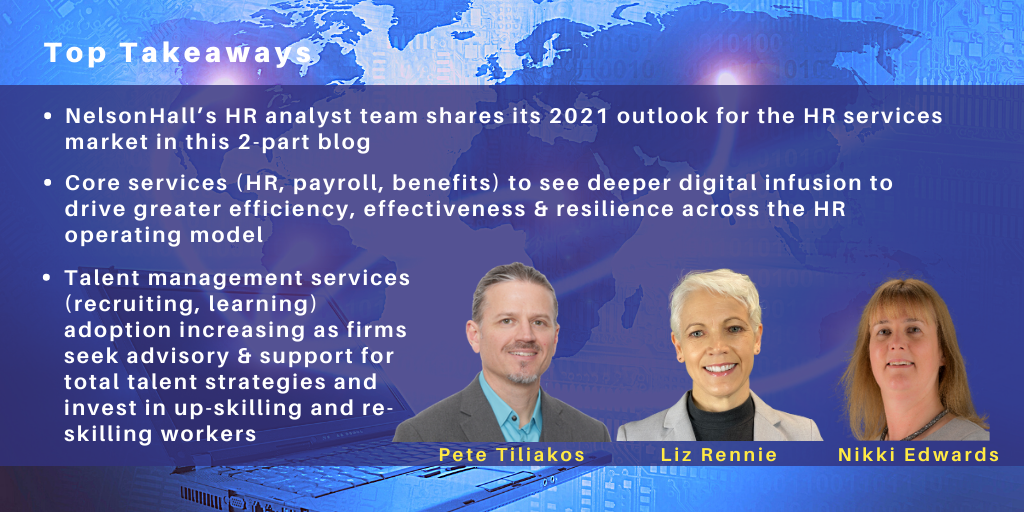posted on Jan 27, 2021 by Nikki Edwards

This is the second part of a 2-part blog presenting an analysis of key trends from NelsonHall's HR Technology & Services team. Here, Nikki Edwards looks at talent management services, including recruitment and learning services.
Recruitment Services
RPO and CWS/MSP vendors shone in 2020, as they supported their clients through their COVID-19 challenges, adding another dimension to an already-complex picture of Talent Acquisition (TA) trends. Vendors initially advised on digital tools to enable remote hiring and onboarding of talent, and broader services around working from home, keeping safe, and maintaining wellbeing.
This was immediately followed by vendor taskforces re-allocating resources to meet organizations’ urgent hiring ramp-ups (particularly in healthcare, pharmaceuticals, and food retail), while supporting clients who were scaling back or needed a different modus operandi. The year closed with recruitment vendors supporting their clients with mid- to long-term TA planning, as remote, and digital hiring and working were becoming the new business-as-usual.
Outlook
While organizations focus on essential hiring in 2021 amidst economic uncertainty, and realize they cannot single-handedly navigate the rapidly-evolving TA trends and ongoing pandemic challenges, they will reach out for third-party vendor support to help them strategize and execute plans to ensure they are hiring-fit and work-fit for the future. As vendors continue to evolve their TA solutions (services and tech/tools), they will also contribute to advancing key TA trends:
A total talent/holistic approach to hiring. NelsonHall research in 2020 showed 90% of major enterprises interviewed recognize the need to embrace a holistic approach to talent acquisition, comprising full-time/permanent, contingent, and internal talent (the latter having been somewhat neglected to date).
Organizations are considering using contingent workers (such as freelancers and gig workers) over full-time/permanent workers to avoid long-term employment costs. Vendors already offering total talent solutions are in a stronger position to support them, as they can vary the proportion of each delivery channel based on changing demands and relocate resources accordingly. With the need for worker compliance intensifying, giving organizations better visibility of data/insights concerning their internal talent is a growth area, closing the gap on this under-used talent pool.
Building talent by upskilling and reskilling organizations’ workers. On the one hand, organizations will continue to seek talent which is in short supply (for example, digital skills, other niche STEM skills, some trades skills). Yet on the other, those organizations will face the reality of skillsets being augmented or replaced by automation, requiring affected workers to be upskilled or reskilled in new areas.
The ‘build’ element of the buy, borrow, build, and bot approach to TA has never been so important. The COVID-19 pandemic highlighted how organizations’ digital skills fell woefully short of what is required for 2021 and the need to address this (notably in areas from basic use of collaboration platforms to advanced cybersecurity). All recruitment vendors will play a role in skills development and embrace the opportunity uniquely according to their client base and their specific needs.
Expansion of talent advisory services. With a more highly distributed and flexibly working workforce here to stay, RPO and CWS/MSP vendors will expand their portfolios to offer services around the future of work. This could encompass the evolution of employer branding/recruitment marketing services pivoted to focus on compelling EVP building – showcasing/storytelling values demonstrated by client organizations through the pandemic.
Opportunities abound in areas beyond TA, encompassing broader HR and organizational issues. Consulting will cover working with a fully-remote, globally spread workforce (covering topics such as tech/tools, employee communications, employee engagement, workforce wellbeing/safety (shielding), workplace redesign, to business continuity planning and building corporate resilience).
Next-generation platforms/tools. In readiness for the new era of work, recruitment vendors will continue investing in data, AI-based predictive analytics (for example, the impact of automation on skills augmentation or replacement), intelligent automation (looking at workflow bottlenecks), niche human clouds, and learning tech (for reskilling/upskilling). Also, chatbots, voice-enabled tools, the use of AI for resume parsing, candidate matching, and assessments will continue apace.
Learning Services
In 2020, Learning Services vendors supported clients in digitalizing in-person training content for cloud-based peer-to-peer platform delivery in a bid to continue essential training (for employee onboarding and business compliance needs). Vendors saw increased demand for specific skills training, notably digital skills and reskilling for COVID-19-specific healthcare/pharmaceutical initiatives. Within a few months, vendors were supporting clients in choosing the most appropriate modalities for delivering learning digitally, whether via simple videos or animation, for example. Although there was some return to socially-distanced classroom training at the close of 2020, organizations recognized that digital learning solutions and updated skillset training were going to be the priority for 2021 as geographically-dispersed, remote workforces become the long-term norm.
Outlook
Organizations will continue to have reduced training budget spend in 2021, until the economic situation improves in a COVID-19 vaccinated world. Vendors must maintain/increase support for their clients as they navigate further challenges, which may include the downsizing or removal of in-house learning teams, while ensuring their employees learn in a safe, collaborative environment, cognizant of pandemic-induced restrictions. Vendors will continue with their planned developments in services/learning tech/tools driven by existing PESTLE factors, yet also advance several learning trends:
Digital/virtual modalities for geographically-dispersed/remote workers. Priority will be on blended learning (with a significant proportion of VILT to enable most learning to take place remotely, with any return to in-person learning reserved for final skills demonstration/reinforcement), and eLearning. Learning will be in bite-sized chunks, embracing engaging modalities to drive self-service pull versus push learning. Such modalities will include video, animation, gamification, simulation, virtual reality (VR), augmented reality (AR), and alternate reality.
Curated content over created content. Learning Vendors will continue to curate content (where there is an abundance of ready-made material available), as organizations seek quick fixes to plug gaps in their content libraries. Created content will remain popular for niche/specialist content, where it is tailored for a specific organization or product, or for compliance reasons.
Learning tech/tools (including tech admin). Augmenting organizations’ existing LMS/LXPs/HCM learning modules with other platforms/tools to enhance the learning experience will expand vendors’ ecosystems. Platforms will include curated content, extended reality, EPSS, microlearning, rapid authoring, and alternate reality. Mobile learning, learner data/analytics, and learning systems admin will continue to grow in importance.
Other services. Consulting services will expand to focus on digitalization of learning (including tech/tools advice as above), driving learner engagement, and reskilling/upskilling, based around the new organizational structures of the future. Administrative services may increasingly focus on third-party learning vendor management, for example, as procurement teams shed administrative duties, and traditional classroom support diminishes in importance.
In Part 1 of this blog, Pete Tiliakos & Liz Rennie look at the key outsourcing trends around core HR functions, including cloud HR transformation, payroll, and benefits administration services.




